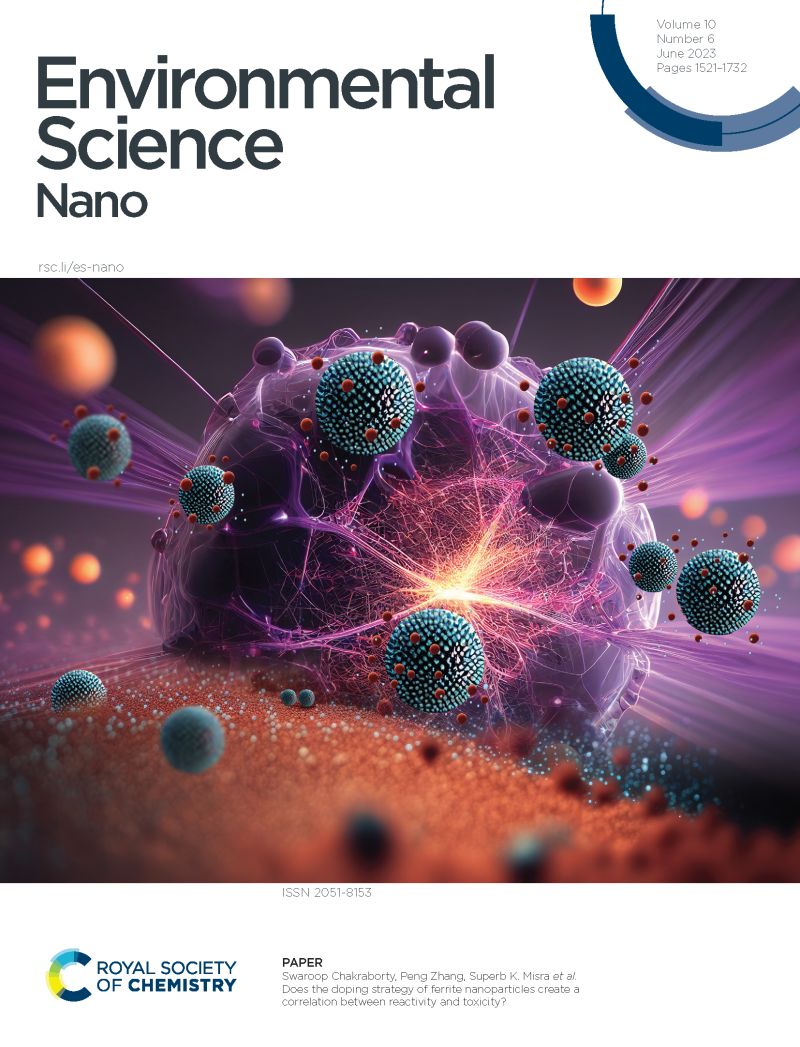取代功能化酞菁铜(CuPc)/氮化碳(g-C3N4)电催化剂同时检测4-硝基苯胺和呋喃托因
IF 5.8
2区 环境科学与生态学
Q1 CHEMISTRY, MULTIDISCIPLINARY
引用次数: 0
摘要
在这项研究中,我们开发了一种简单、高灵敏度的电化学技术,用于检测水样中的4-硝基苯胺(4-NA)和硝基呋喃酮(NFT),利用氮化石墨碳(g-C3N4)修饰的吸电子基团(Cl和F)功能化酞菁铜(CuPc)。CuPc和g-C3N4表现出一致的π -π堆叠相互作用,CuPc上的吸电子取代基增强了4-NA和NFT的电化学敏感性,而Cu(II)则是单原子催化剂。利用循环伏安法(CV)和差分脉冲伏安法(DPV)对4-NA和NFT在不同pH水平、扫描速率和浓度下的电化学性能进行了评价。Cl-CuPc/g-C3N4具有较强的电催化活性,表现出较好的电化学性能,具有良好的选择性、重复性和再现性。结果表明,4-NA的线性响应范围为0.2498 ~ 589.3 μM, NFT的线性响应范围为0.2498 ~ 589.3 μM。该方法对两种分析物的检测限均为6 nM,具有较高的灵敏度。环境水样分析表明,存在痕量的4-NA和NFT。因此,开发了Cl-CuPc/g-C3N4,在双重检测中表现出更高的有效性。因此,所采用的简单、经济的催化剂在进一步改性后可用于各种电化学应用。本文章由计算机程序翻译,如有差异,请以英文原文为准。

Substitution-functionalized copper phthalocyanine (CuPc)/carbon nitride (g-C3N4) electrocatalysts for the simultaneous detection of 4-nitroaniline and nitrofurantoin
In this study, we developed a straightforward and highly sensitive electrochemical technique for detecting 4-nitroaniline (4-NA) and nitrofurantoin (NFT) in water samples, utilizing electron-withdrawing group (Cl and F) functionalized copper phthalocyanine (CuPc) modified with graphitic carbon nitride (g-C3N4). CuPc and g-C3N4 exhibit consistent π–π stacking interactions, with electron-withdrawing substituents on CuPc enhancing the electrochemical sensitivity of 4-NA and NFT, while Cu(II) serves as a single-atom catalyst. The electrochemical performances of 4-NA and NFT were evaluated using cyclic voltammetry (CV) and differential pulse voltammetry (DPV) at various pH levels, scan rates, and concentrations. Cl-CuPc/g-C3N4 has been shown to have enhanced electrocatalytic activity, demonstrating better electrochemical performances with good selectivity, repeatability, and reproducibility. Consequently, we achieved an extensive linear response range of 0.2498–589.3 μM for 4-NA and 0.2498–589.3 μM for NFT, respectively. It achieved a low detection limit of 6 nM for both analytes, demonstrating high sensitivity. The analysis of environmental water samples indicated the presence of trace amounts of 4-NA and NFT. Consequently, Cl-CuPc/g-C3N4 was developed, demonstrating enhanced effectiveness in dual detection. Thus, the employed simple and cost-effective catalysts will be useful with further modification in various electrochemical applications.
求助全文
通过发布文献求助,成功后即可免费获取论文全文。
去求助
来源期刊

Environmental Science: Nano
CHEMISTRY, MULTIDISCIPLINARY-ENVIRONMENTAL SCIENCES
CiteScore
12.20
自引率
5.50%
发文量
290
审稿时长
2.1 months
期刊介绍:
Environmental Science: Nano serves as a comprehensive and high-impact peer-reviewed source of information on the design and demonstration of engineered nanomaterials for environment-based applications. It also covers the interactions between engineered, natural, and incidental nanomaterials with biological and environmental systems. This scope includes, but is not limited to, the following topic areas:
Novel nanomaterial-based applications for water, air, soil, food, and energy sustainability
Nanomaterial interactions with biological systems and nanotoxicology
Environmental fate, reactivity, and transformations of nanoscale materials
Nanoscale processes in the environment
Sustainable nanotechnology including rational nanomaterial design, life cycle assessment, risk/benefit analysis
 求助内容:
求助内容: 应助结果提醒方式:
应助结果提醒方式:


